Wednesday, 24 September, 2014. 08:30
Aït Benhaddou is a popular tourist spot because it is a day trip from Marrakesh. Apparently the village here is swarming with tourists at lunch time, and becomes deserted overnight. Although the hotel we’re staying at seems to have hundreds of rooms, and a luxurious swimming pool, we seem to be the only people staying here.
We woke with the alarm at 07:15 after probably the best sleep of the trip so far. Breakfast from 07:30 was a familiar looking selection of bread, jam, honey, boiled eggs, and freshly curled butter in a dish. The fried bread here was small squares which looked different to the donut rings in other places, but tasted the same. The bowl of apricot jam was enormous, a huge salad bowl full of the stuff. We were the first there on the terrace, joined by Leanne and Michelle and Terry soon after. The view from the terrace was amazing, on to a sunlit slope of mud brick buildings. After packing the bus we are heading on an hour long walk through the village up that hill to see the view before driving to Marrakesh.
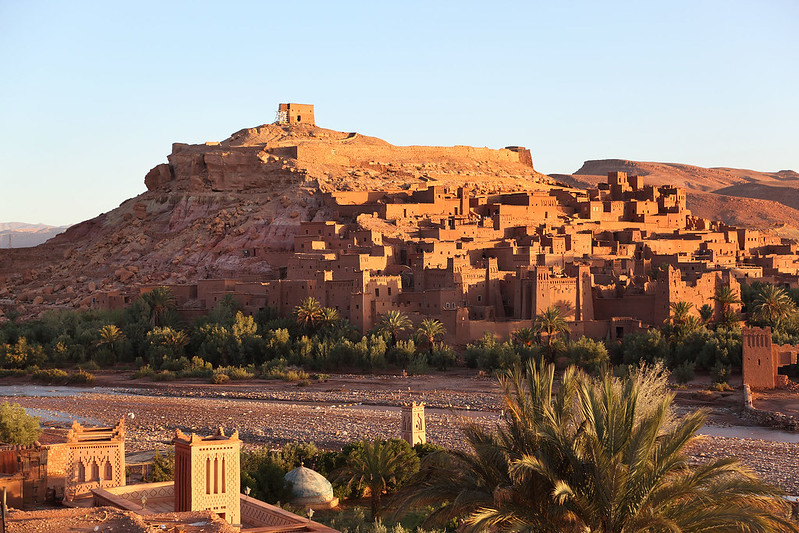 View of Ksah Aït Benhaddou from breakfast. |
10:12
We are on the road again, after a morning walk through the village of Aït Benhaddou to see the Ksah Aït Benhaddou, which is a World Heritage Site. The mud brick buildings tumble down a small hill, with an old communal granary at the very top. The site is across a river from the modern village, and Lahcen said normally there is no water at all in the river, but today there was a wide, shallow flow from the recent rain. We crossed a modern concrete footbridge and then climbed the narrow winding alleys to the top. A large group of Japanese tourists overtook us as we stopped to look at an artist making watercolour paintings using indigo, tea, sugar, and saffron. As he painted, most of the picture was a pale yellow. When done, he heated the paper over a propane flame, caramelising the sugar to make it a dark brown, bringing out the design. They were only 30 dirhams so we bought one on the way back down.
 Climbing Ksah Aït Benhaddou from breakfast. |
At the top, a bunch of men were erecting fake stone walls lined with fibreglass to extend the granary, to make it appear larger for the New Adventures of Aladdin which is filming here at the moment. Further down men were building a picket stockade, which I assume is also for the film. After filming, this stuff will be removed again. We also saw a circular depression at the bottom of the hill, which was where the African arena scenes in Gladiator were filmed. Other films made here include Indiana Jones and the Last Crusade, Cleopatra, The Jewel of the Nile, and some bits of Game of Thrones.
The view from the top was pretty good, looking over the river below, the modern village, and then out into the surrounding rocky landscape and the distant mountains. Ben said on the way down that the Japanese tourists had erected a tripod and reflecting screen to take professional photos of everyone in the group, in front of the scenery. Being a day trip from Marrakesh, I can see why this place is crowded at lunch time.
 View from top of Ksah Aït Benhaddou from breakfast. |
11:43
We are leaving a coffee and toilet stop, at a cafe and Restaurant Rafik, which has an attached tourist trap shop with some very fake looking ammonite “fossils” which look like they’re made of clay. The valley we’re driving up is flanked with low but sharp hills with eroded rock strata sticking out at all sorts of angles, the rock above is red, but there had been some very green soil and rock in the lower parts, which is almost certainly copper ore.
 Climbing up the High Atlas mountains. |
14:37
We’ve just had lunch at a truck stop sort of place high in the High Atlas mountains, just over the pass of Tizi n’Tichka. This was Taddart Oufella (or “Upper Taddart”; there is also a Taddart Izdar, presumably “Lower Taddart”, another couple of kilometres down the road). The place looked like essentially a row of food places and shops along the road, with no signs of any residential village nearby. A lot of cars and trucks were stopped there, getting food. We went into one place where there were freshly slaughtered cuts of sheep hanging out the front, including a sheep’s head. The idea was you bought the meat raw, then paid a few dirhams to have the cafe cook it for you over their charcoal fire. You could either have chops, or they would grind it in a hand grinder and make kefta. Lahcen ordered a kilo of chops and a kilo of kefta for us to share, as well as Berber omelettes for M. and three others who wanted a meatless option. I also ordered a salad to go with the meat. The salad was finely chopped tomato, red onion, cucumber, and green capsicum, seasoned with salt, black pepper, and a touch of cumin. The meat was brought out hot from the fire and was delicious.
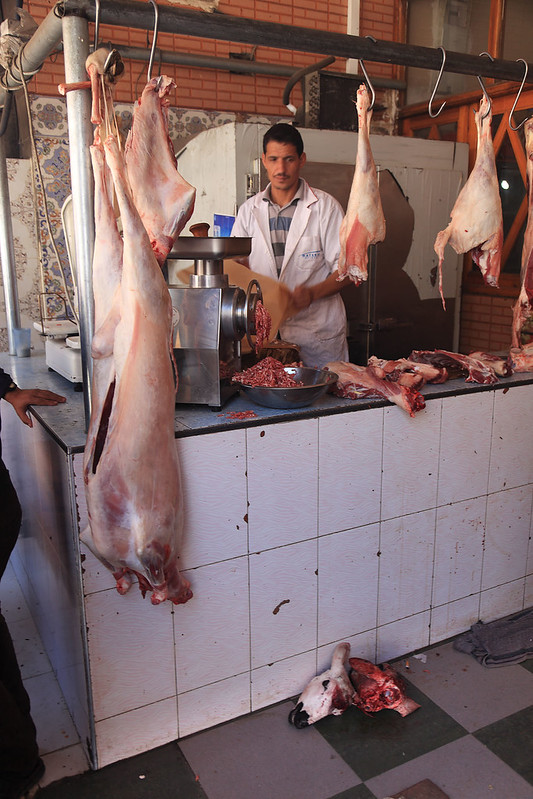 Choose your own lunch. |
Earlier we stopped at the Takarkourte women’s cooperative in a small town (whose name I did not find out). Here women were making argan oil, by cracking and grinding the nuts of the argan tree. The argan tree is native only to Morocco, and the oil it produces has become popular for use in cosmetics. When the bus parked and we walked into the building, we noticed that the crunchy gravel-like area in front was paved not with gravel, but with millions of nut shells. Inside, women we working at cracking and grinding the nuts by hand. A woman gave us a brief tour of how the oil was produced, and some of the products made with it. The nuts are also edible, and can be used to make paste a bit like peanut butter. We got to sample some, sweetened with honey, which the woman described as “Berber Nutella”. It was delicious, and we considered buying some, but it was very expensive. Argan products are all expensive, because of the labour intensive processes needed to extract the nuts and oil. I asked if any places used machines to extract the oil, and was told no, because it was a traditional product and to maintain its cultural heritage status it was all done by hand. Some of the others bought some of the argan products, and we just bought some moisturising cream, since our tube of moisturiser we brought with us is running out.
 Women extracting argan oil. |
We continued along the road up into the mountains. We stopped at the top of the Tizi n’Tichka pass, at 2260 metres, for a photo opportunity. The place was crammed with tourist trap shops and cafes. Now we’re continuing down this incredible windy road towards Marrakesh.
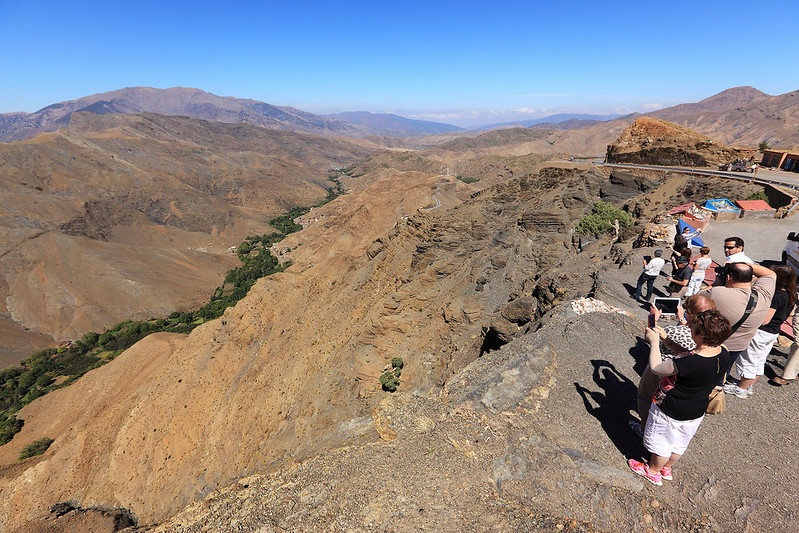 View from Tizi n’Tichka pass, 2260 metres. |
Lahcen was telling us on the bus about the three types of licensed tour guides in Morocco. First there are local guides, who need two years of university, followed by training in one particular location. These are the guides such as Atimadh and Hakima who showed us around the cities. Then there are national guides, who need a degree plus additional training and need to pass difficult exams to qualify. They lead large groups of 40 to 50 people around on tours of the major cities, and do not need to defer to a local guide in each city – they know enough to lead the groups everywhere except in the mountains or desert. Lastly there are the mountain guides, which Lahcen is. These need a high school graduation as a minimum, plus additional training, and they have to pass a three day examination consisting of written tests on day one, oral exams on day two, and then running a full marathon in the mountains, with 25 kilometres of uphill, on day three, and they have to finish the race in the top 40 of the examination class to qualify (but he didn’t say how many were in the class). The mountain guides are not qualified to lead tours in the cities, which is why he must call in local guides for those.
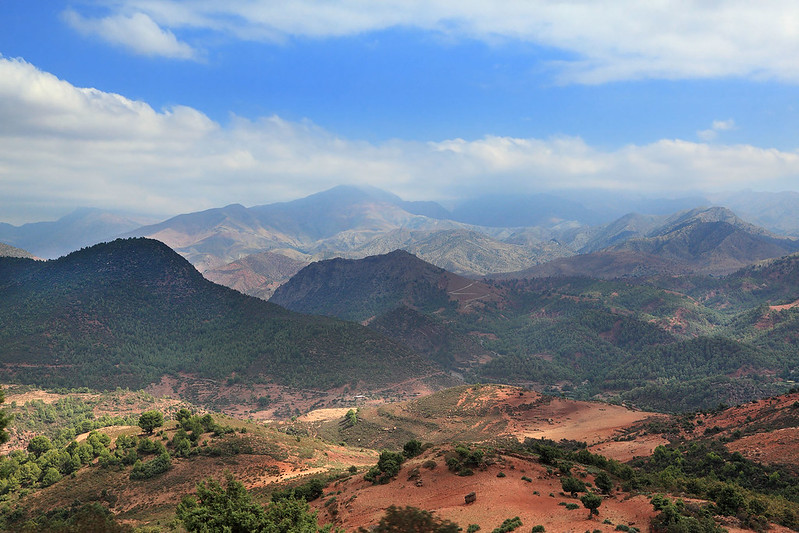 Descending through the High Atlas mountains. |
16:25
We are entering Marrakesh, and just passing a golf course. Lahcen says there are “many golf courses in Marrakesh, at least six.”
22:10
We’ve arrived back at our hotel after dinner in Jemaa el-Fnaa, the main square of Marrakesh, which was a real experience.
Mohammed drove our bus towards the Riad Maison Rouge, where we are staying for the last two nights of the tour, plus our extra night before we fly out. He got to a small square full of traffic and had to stop, as the street leading to the riad had “no entry” signs flanking it, which weren’t there last time he or Lahcen were here. Lahcen got out and talked to some people and discovered that the signs were added just four days ago, after a nasty traffic accident in that street we were going to drive down. Lahcen instructed us to get out of the bus, as we were leaving it and Mohammed here, and he was getting porters to carry our bags the remainder of the way to the riad, and we would have to walk about five minutes to get there.
 Arrival in Marrakesh. That’s a porter hauling our bags ahead. We had to walk down the “no entry” street a few hundred metres to our hotel. |
After he helped the porters to unload the bags and pack them into large wheelbarrow carts, we said goodbye to Mohammed, and Ben gave him the collected tips from everyone. Throughout the tour we all thought he was a really good driver, and could tell he was being careful and aware of road safety all the time, taking things slowly rather than taking any risks, especially with things like overtaking slow vehicles, winding mountain roads, the unpaved desert road, and slippery sections covered with mud from the rain.
The porters led the way to our riad and we arrived a bit later, checking into the “Marrakesh” room on the first floor, overlooking the courtyard which has orange trees growing in it, with fruit just turning ripe. Up another floor is a rooftop terrace with a small lap pool and an honesty system bar. We had an hour before meeting for dinner at 19:00, and several others used the pool and/or had some wine on the roof.
 View from our room at Riad Maison Rouge, into interior courtyard. |
For dinner Lahcen led us to the Jemaa el-Fnaa square. It was about fifteen minutes walk, through some narrow alleys then out into a small paved square with a few cars parked in it, then out to a narrow street with lots of motorcycle traffic and the occasional car, on to a Main Street with lots of cars, then turning into a pedestrian mall festooned with lamp posts and touristy looking shops and crowded with people walking to and fro, and then into the square itself, which was a complete knock out for the senses. It was pulsing with people, snake charmers, monkeys, and over one side hundreds of food stalls. The stalls were numbered and many had tables and benches set up for diners in front of the arrayed food which they cooked fresh. We stopped at stall 41, Chez Ssaid, which apparently Lahcen had called ahead to book, since a table was laid out and ready for us.
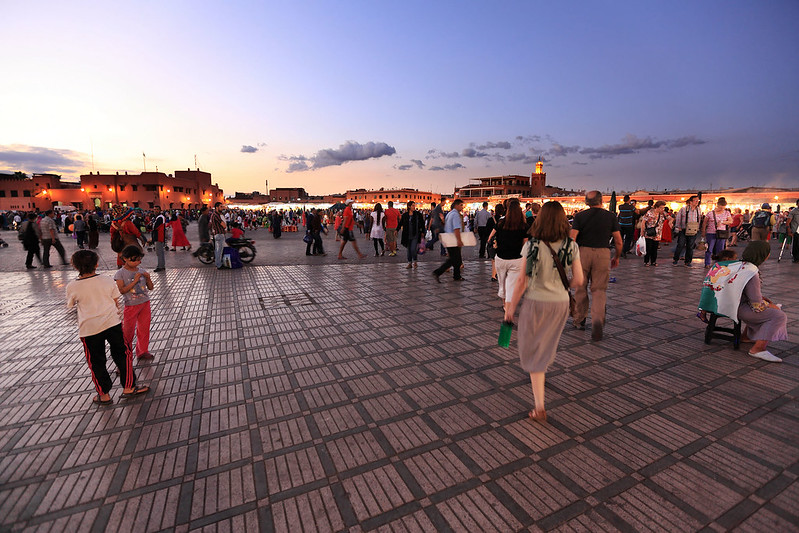 Jemaa el-Fnaa. |
This dinner was included in our tour, and Lahcen had ordered a mixture of stuff, which came out in sequence: bread, olives, minced tomatoes, salad of tomato, cucumber, beetroot, potato, carrot, then plates of grilled eggplant, green capsicum, and potato patties, with a spicy chili sauce, then beef and chicken skewers, couscous with potato, zucchini, carrot, and turnips, then vegetable skewers with tomato, onion, and capsicum, then calamari rings. Zi showed up partway through having skipped the meeting for dinner to go the airport and meet her boyfriend, who was joining her here in Marrakesh. She happened to find us completely by accident, walking past where we were sitting in the crowded square. So they joined us as well, and ordered a mix of dishes, which included some sausages, which we swapped their extras for some our calamari rings, so we got to try those as well. Lahcen ordered a special dish just for him, which had lamb’s brains and some other cuts of meat which I couldn’t identify. After eating, people had mint tea, although I didn’t get any.
 Dining at Chez Ssaid in Jemaa el-Fnaa. |
While we were eating, several beggars came up to our table, asking for food or money. Lahcen told us to ignore them, and the stall owner was on patrol near us, shooing them away. Lahcen has told us that many people are professional beggars, and can actually make a good living from it. Some women even hire babies to carry while begging, and some drug the babies to make them look sleepy. He says the only way to avoid encouraging this sort of thing is not to give any of them any money.
 Some of the many food stalls in Jemaa el-Fnaa. |
Lahcen suggested we try a spicy drink after dinner, made with ginger, galangal, and several other herbs. It came hot in tea glasses, and was a deep red colour. A whiff was enough to clear the sinuses, and everyone who smelt it had the same reaction of being suddenly overpowered by the smell. But once you drank it, it was quite pleasant, sweetish, but spicy, with the kick of ginger. It was really delicious. Lahcen joked that it would kill any bugs in our stomachs from the food. We paid three dirhams for the spicy drink, and I asked Lahcen what it was called. He replied “spicy drink”, but then said that he called it galangal, since that was one of the ingredients.
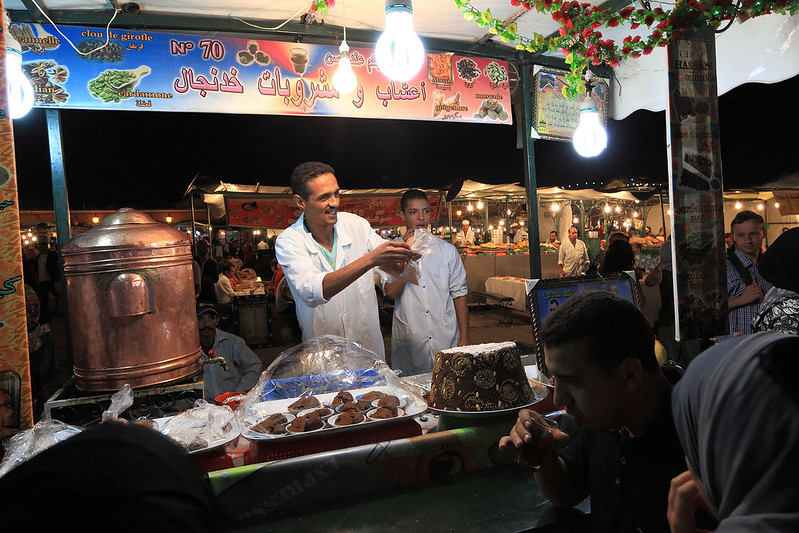 The “spicy drink” vendor. |
After the spicy drink, Lahcen led us back to the riad. He showed us the nearest street area to the riad, where our transfers to the airport will pick us up one by one as we disperse to our different flights. Then he turned around to lead us to the riad. As we walked down the alley to the small square with parked cars, a motorcycle sped past and a passenger tried to snatch Heather’s handbag. Fortunately she had it held tightly around her neck, and she didn’t lose it, but she said the tug had hurt her neck. As the bike sped off, we yelled and Lahcen yelled ahead to where a couple of people in safety vests tried to stop the bike, but they couldn’t grab it. A bit shaken, we headed back to the riad and turned in for the night. Ben later told me that Lahcen said the vested guys were a sort of vigilante group, trying to protect tourists and citizens from petty crime.
